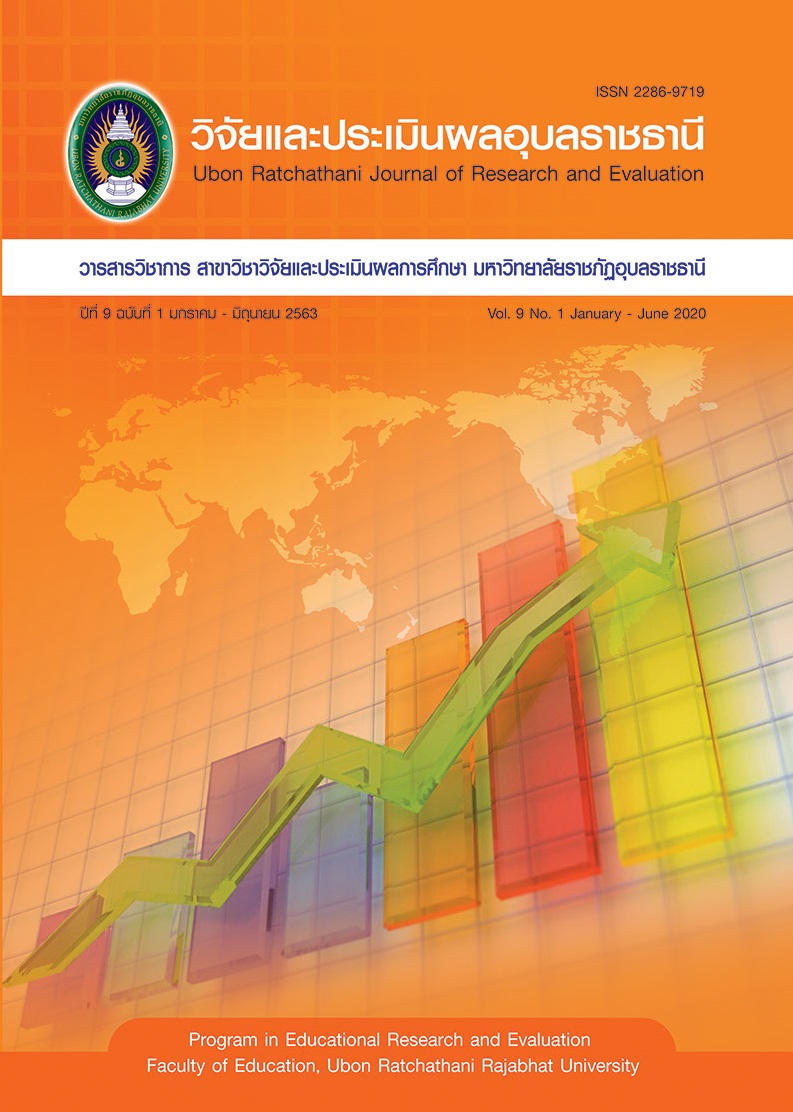ผลของการจัดการเรียนรู้เชิงรุกในวิชาภาษาไทยที่มีต่อความสามารถในการใช้ภาษาเพื่อการสื่อสารในการเรียนการสอนของนักศึกษาชั้นปีที่ 1 คณะครุศาสตร์ มหาวิทยาลัยราชภัฏอุบลราชธานี
คำสำคัญ:
การจัดการเรียนรู้เชิงรุก, วิชาภาษาไทย, ความสามารถในการใช้ภาษาเพื่อการสื่อสารบทคัดย่อ
การวิจัยครั้งนี้มีวัตถุประสงค์ 1) เพื่อศึกษาผลของการจัดการเรียนรู้เชิงรุกในวิชาภาษาไทยที่มีต่อความสามารถในการใช้ภาษาเพื่อการสื่อสารในการเรียนการสอนของนักศึกษาคณะครุศาสตร์ มหาวิทยาลัยราชภัฏอุบลราชธานี และ 2) เพื่อเปรียบเทียบความสามารถในการใช้ภาษาเพื่อการสื่อสารในการเรียนการสอนก่อนและหลังการทดลองของนักศึกษาที่เรียนด้วยการจัดกิจกรรมการเรียนรู้เชิงรุกในวิชาภาษาไทยและนักศึกษาที่ไม่ได้รับการจัดกิจกรรม
การเรียนรู้เชิงรุกในวิชาภาษาไทย ตัวอย่างได้แก่ นักศึกษาชั้นปีที่ 1 สาขาวิชาการประถมศึกษา คณะครุศาสตร์ มหาวิทยาลัยราชภัฏอุบลราชธานี จำนวน 60 คน เครื่องมือที่ใช้ในการวิจัย ได้แก่ แผนการจัดกิจกรรมการเรียนรู้เชิงรุกในวิชาภาษาไทย และแบบวัดความสามารถในการใช้ภาษาเพื่อการสื่อสารในการเรียนการสอน สถิติที่ใช้ในการวิเคราะห์ข้อมูลคือ ค่าเฉลี่ย ส่วนเบี่ยงเบนมาตรฐาน และการทดสอบค่าที
ผลการวิจัยพบว่า
- นักศึกษาที่ได้รับการจัดการเรียนรู้เชิงรุกในวิชาภาษาไทย มีค่าเฉลี่ย ( ) ของคะแนนความสามารถ
ในการใช้ภาษาเพื่อการสื่อสารในการเรียนการสอน ก่อนเรียนเท่ากับ 9.02 และหลังเรียนเท่ากับ 23.67 ผลการวิจัย พบว่า นักศึกษาที่ได้รับการจัดการเรียนรู้เชิงรุกในวิชาภาษาไทยหลังการทดลอง มีค่าเฉลี่ยคะแนนความสามารถ
ในการใช้ภาษาเพื่อการสื่อสารในการเรียนการสอนสูงกว่าก่อนเรียนอย่างมีนัยสำคัญทางสถิติที่ระดับ .05 - ความสามารถในการใช้ภาษาเพื่อการสื่อสารในการเรียนการสอนของนักศึกษาที่ได้รับการจัดการเรียนรู้เชิงรุกในวิชาภาษาไทยมีค่าเฉลี่ย ( ) เท่ากับ 23.67 และ 19.51 ผลการวิจัยพบว่า นักศึกษาที่ได้รับการจัดกิจกรรมการเรียนรู้เชิงรุกในวิชาภาษาไทยมีความสามารถในการใช้ภาษาเพื่อการสื่อสารในการเรียนการสอนสูงกว่านักศึกษาที่ไม่ได้รับการจัดกิจกรรมการเรียนรู้เชิงรุกในวิชาภาษาไทยอย่างมีนัยสำคัญทางสถิติที่ระดับ .05
เอกสารอ้างอิง
นนทลี พรธาดาวิทย์. (2559). การจัดการเรียนรู้แบบ Active learning (พิมพ์ครั้งที่ 2). กรุงเทพฯ: ทริปเพิ้ล เอ็ดดูเคชั่น.
Prontadavit, N. (2016). Active Learning Management (2nd ed). Bangkok: Triple Education. [in Thai].
ปราวีณยา สุวรรณณัฐโชติ. (2551). การเรียนรู้เชิงรุก (Active Learning). กรุงเทพฯ: จุฬาลงกรณ์มหาวิทยาลัย.
Suwannatthachote, P. (2008). Active Learning. Bangkok: Chulalongkorn University. [in Thai].
เรียม ศรีทอง. (2542). พฤติกรรมมนุษย์กับการพัฒนาตน. กรุงเทพฯ: เธิร์ดเวฟ เอ็ดดูเคชั่น.
Sritong, R. (1999). Human Behavior and Self-Development. Bangkok: Third Wave Education. [in Thai].
วัชรา เล่าเรียนดี, ปรณัฐ กิจรุ่งเรือง และอรพิณ ศิริสัมพันธ์. (2560). กลยุทธ์การจัดการเรียนรู้เชิงรุกเพื่อพัฒนาการคิดและยกระดับคุณภาพการศึกษา สำหรับศตวรรษที่ 21 (พิมพ์ครั้งที่ 12). นครปฐม: เพชรเกษมพริ้นติ้ง.
Laowreandee, W., Kitroongrueng, P. & Sirisamphan, O. (2017). Active learning instructional strategies for thinking development and educational improvement of the 21st century (12th ed). Nakhon Pathom: Phetkasem Printing. [in Thai].
สำนักงานคณะกรรมการพัฒนาการเศรษฐกิจและสังคมแห่งชาติ. (2559). แผนพัฒนาเศรษฐกิจและสังคมแห่งชาติ ฉบับที่ 12. กรุงเทพฯ: สำนักงานคณะกรรมการพัฒนาการเศรษฐกิจและสังคมแห่งชาติ.
Office of the National Economic and Social Development Board. (2016). The Eleventh National Economic and Social Development Plan (2017-2011). Bangkok: Office of the National Economic and Social Development Board. [in Thai].
เสาวณีย์ สิกขาบัณฑิต. (2534). การเขียนสำหรับสื่อการสื่อสาร (พิมพ์ครั้งที่ 2). กรุงเทพฯ: ดวงกมล.
Sikkhabandit, S. (1991). Writing for communication media (2nd ed). Bangkok: Duangkamon. [in Thai].
Lemke, Cheryl. (2010). “Innovative Through Technology,” 21st Century Skills. In James Bellanca and Ron Brandt (eds). Rethinking How to Students Learn. p. 246, 267. Bloomington, IN: Solution Tree.
Lorenzen, M. (2001). Active learning and library instruction. Illinois Libraries, 83(2), 19-24.
Raymond, A. (1997). Inconsistency between a beginning elementary school teacher’s mathematics beliefs and teaching practices. Journal Research in Mathematics Education, 28(5), 550-576.
ดาวน์โหลด
เผยแพร่แล้ว
รูปแบบการอ้างอิง
ฉบับ
ประเภทบทความ
สัญญาอนุญาต
1. บทความที่ตีพิมพ์ในวารสารนี้ได้มีการตรวจสอบการลอกเลียนงานวรรณกรรมแล้ว ไม่เกินร้อยละ 25
2. บทความที่ตีพิมพ์ในวารสารนี้เป็นข้อคิดเห็น ข้อค้นพบของผู้เขียนบทความ โดยผู้เขียนบทความต้องเป็นผู้รับผิดชอบต่อผลทางกฎหมายใด ๆ ที่อาจเกิดขึ้นจากบทความนั้น ๆ
3. บทความ ข้อมูล เนื้อหา รูปภาพ ฯลฯ ที่ได้รับการตีพิมพ์ในวารสารวิจัยและประเมินผลอุบลราชธานี ถือเป็นลิขสิทธิ์ของวารสารวิจัยและประเมินผลอุบลราชธานี หากบุคคลหรือหน่วยงานใดต้องการนำทั้งหมดไปเผยแพร่ต่อหรือเพื่อกระทำการใดๆ จะต้องได้รับอนุญาตเป็นลายลักษณ์อักษรจากวารสารวิจัยและประเมินผลอุบลราชธานีก่อนเท่านั้น และจะต้องมีการอ้างอิงวารสารวิจัยและประเมินผลอุบลราชธานี ฉบับนั้น ๆ ด้วย






